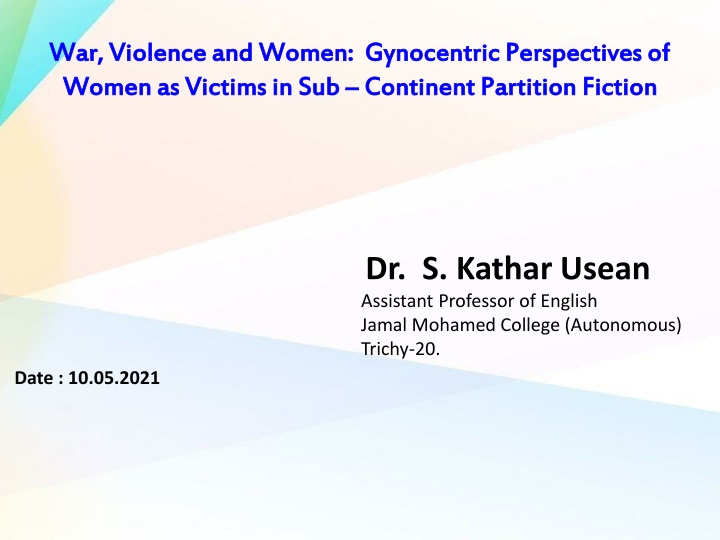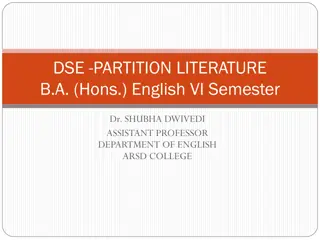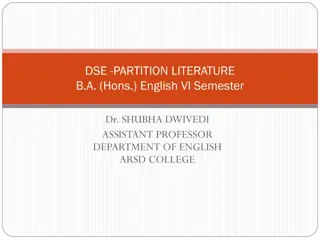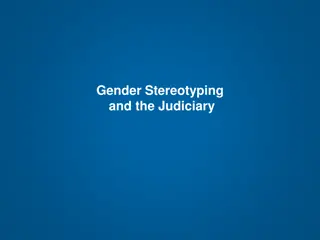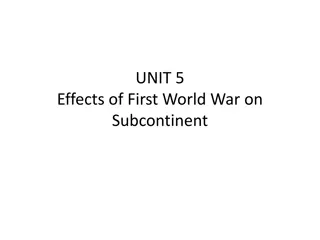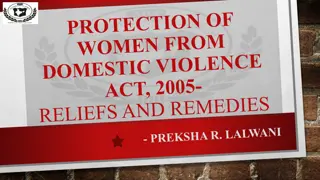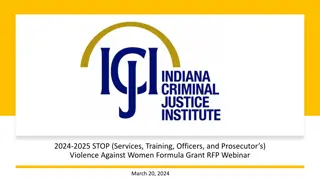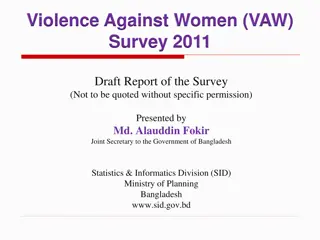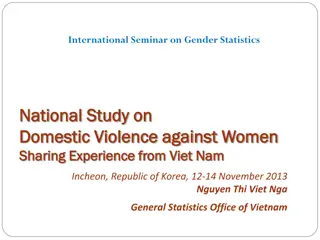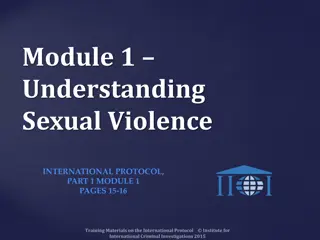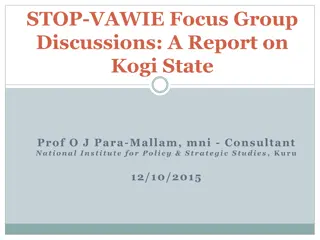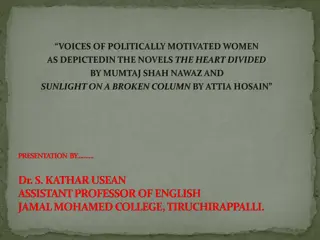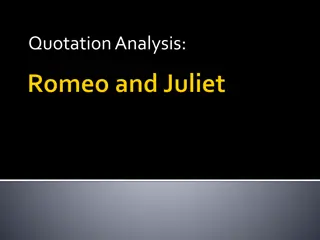War, Violence, and Women in Subcontinent Partition Fiction: A Literary Analysis
This research work delves into the portrayal of gynocentric perspectives focusing on women as victims in the works of female novelists from South Asia regarding the India-Pakistan Partition and the Bangladesh War. The study examines six novels by authors such as Jyotirmoyee Devi, Attia Hosain, Mumtaj Shah Nawas, Bapsi Sidhwa, Sorayya Khan, and Tahmima Anam. Through in-depth analysis, the text explores the conditions of women during these tumultuous historical events, shedding light on their roles and struggles.
Download Presentation

Please find below an Image/Link to download the presentation.
The content on the website is provided AS IS for your information and personal use only. It may not be sold, licensed, or shared on other websites without obtaining consent from the author.If you encounter any issues during the download, it is possible that the publisher has removed the file from their server.
You are allowed to download the files provided on this website for personal or commercial use, subject to the condition that they are used lawfully. All files are the property of their respective owners.
The content on the website is provided AS IS for your information and personal use only. It may not be sold, licensed, or shared on other websites without obtaining consent from the author.
E N D
Presentation Transcript
War, Violence and Women: War, Violence and Women: Gynocentric Women as Victims in Women as Victims in Sub GynocentricPerspectives of Perspectives of Sub Continent Partition Fiction Continent Partition Fiction Dr. S. Kathar Usean Assistant Professor of English Jamal Mohamed College (Autonomous) Trichy-20. Date : 10.05.2021
War, Violence and Women: Gynocentric Perspectives of Women as Victims in Sub Continent Partition Fiction Examines literary texts written purely by women novelists of South Asia & their significant literary representations of the 1947 India - Pakistan Partition and 1971 Bangladesh War. The conditions of victimised women during the time of India Pakistan Partition and Bangladesh War of Independence.
Totally six novels have been selected for the present research work, written by six female novelists belonging to different countries such as India, Pakistan and Bangladesh. Indian Novelists - 1. Jyotirmoyee Devi 2. AttiaHosain Pakistan Novelists - 3.Mumtaj Shah Nawas 4. BapsiSidhwa Bangladesh Novelists - 5. Sorayya Khan 6. TahmimaAnam
Mumtaj Shah Nawas Jyotirmoyee Devi s Attia Hosain s Bapsi Sidhwa s - Investigate the conditions of women during the Partition of India in 1947. The other two novels : Sorayya SorayyaKhan s Khan s Noor Noor Tahmima TahmimaAnam s Anam s - -A A Golden Age - Portray the active role of Bangladeshi women in 1971 War of Independence and victimized women during the time. - The Heart The Heart Divided - The The River River Churning - Sunlight on a Broken Column Sunlight on a Broken Column - Cracking India Cracking India Divided Churning Golden Age
First Chapter -I - Introduction Chapter -II - History, Politics, Violence and Women in Partition Fiction Chapter -III - Abducted Women and Forced Marriages in Partition Fiction Chapter-IV - Voices of Female Children: Traversing the Partition through the Lens of Child Narrators and Childhood Experiences Chapter V - Conclusion
First Chapter I - Introduction The growth and development of South Asian Literature. The background history of 1947 Partition & 1971 Bangladesh War of Independence. The actual transfer of power to India and Pakistan proved to be bloody and bitter. It has been described as one of the ten great tragedies of the twentieth century.
- Introduction The fight against the British rule was converted to fight among Indians. Neighbours killed their neighbours & friends killed their friends. Who was responsible for India Pakistan Partition? Muslim League and Mohamed Ali Jinnah ? or Congress, Sangh Parivar and V.D.Savarkar? The idea of Pakistan was a creation of extremists on both sides of the religious divide.
First Chapter I - Introduction Bangladesh's War of Independence began March 25, 1971 when Pakistan launched a bloody crackdown against Bangladeshi civilians and ended on December 16, 1971. What were the reasons for Bangladesh War of Independence? West Pakistan & East Pakistan Political Dominance Language Financial Issues, etc., - Urdu Vs Bengali Exactly what happened between those two dates -- in particular the number of dead -- is still the subject of controversy.
First Chapter I - Introduction The term Gynocentrism derived from the Greek word gyno, meaning "woman, Gynotexts - written by women. The literature written by women about women issues documents the realities of their physical and psychological sufferings . Difference between the Male and Female narration. Women do not articulate things in the same way as men generally do. The biographical details of all the six novelists and plot summary is also given.
Chapter - II History, Politics, Violence and Women in Partition Fiction Demonstrates how the selected writers view the politics behind the division of the country. Elaborates how the inclusion of texts on the theme of Partition that represent women s lives in the domestic sphere , the involvement of women in politics and their sufferings during the time of Partition.
Chapter - II History, Politics, Violence and Women in Partition Fiction Mumtaj Shah Nawaz - The Heart Divided Portrays the peaceful, socio-cultural co-existence among the Hindus and the Muslims, before it was shattered by a number of factors. Jamaluddin, a Muslim aristocrat, & Diwan Kailash NathKaul, a Hindu, belonging to upper class, exchange turbans and take the vow of brotherhood. Nawaz uses the motif of a failed Hindu- Muslim love affair portrayed that the synthesis of Hindu-Muslim culture is only skin deep and shallow. For example; A Muslim boy, Habib falls in love with a Hindu girl, Mohini. Nawaz depicts that, it is impossible and unthinkable for the Hindus and the Muslims to unite in marriage. Both the families were against the marriage.
Chapter - II History, Politics, Violence and Women in Partition Fiction Seen from the Muslim point of view, the Congress appeared guilty of many sins of omission and some of commission. "Nationalism" increasingly began to mean thinking and living in the Congress way. Those who lived or thought another way were treated as anti-national. The liberal Muslim women like Zohra, the protagonist are very upset at this deadlock between the two communities. sub-continent and the creation of Pakistan. Shah Nawaz portrays three major factors responsible for the Partition of the First of all, it is the historical, religious and cultural differences between the Hindus and the Muslims. Secondly the role played by the colonizers . Thirdly, it was the inflexible and insensitive attitude of the Congress and the caste Hindus, which totally disappointed the Muslim leadership.
Chapter - II History, Politics, Violence and Women in Partition Fiction Thinking from the Pakistani point of view, Shah Nawaz argues that the Muslims are convinced that Partition might not be the best solution, but it is the only solution. In short, those who wanted separate nation for Muslims were afraid of their safety in the Hindu dominated India. Like Mumtaj Shah Nawaz, Attio Hosain also depicts the lives of conventional Muslim women in her novel Sunlight on a Broken Column. Many similarities between The Heard Dividedand Sunlight on a Broken Column. Laila of Attia Hosain s novel very often reminds the reader Zohra of The Heart Divided. Like Zohra, Laila too able to get her University education and to involve into active politics.
Chapter - II History, Politics, Violence and Women in Partition Fiction Recollection of the memories of disintegration of a family due to political changes. Story of the journey of a girl Laila who has lost her parents in her early childhood and her growing consciousness and the development of the selfhood partition in its backdrop. Characters not only react but also participate in the political goings on in the country. Articulates the struggle for power politics. Exposes the role of the British who generated the communal struggle and succeeded in weakening the nationalist movement by their famous policy of dividing the communities into two.
Chapter - II History, Politics, Violence and Women in Partition Fiction Politics begins to have an effect on the family affairs seriously. The father and son are holding to two diverse ideologies. As a nationalist Muslim, Uncle Hamid views the Muslim League communal. But his son Saleem admits that the Indian National Congress is an anti Muslim organization. Besides exposing the role played by the British who were motivating the hatredness between the Hindus and Muslims, the novel Sunlight on a Broken Column exposes the crisis within the Muslim community itself. Muslims were torn between two stands; one is pro-Pakistan, demanding the division of the country & second is pro-India, supporting the united India. .
Chapter - II History, Politics, Violence and Women in Partition Fiction Both Zahid and Asad are Muslims, they have different outlook about religion their religion. While Asad s secular outlook makes him to stay back in India, Zahid maintains a rigid fundamentalist view. The Pre-partition period was known for Feudalism and communal harmony. People respected each other s religious values and joined hands together to fight against the British. The Muslims celebrated the Hindu Festivals like Diwali, Holi. However, political changes in the sub continent led to the decline of Feudalism.
Chapter - II History, Politics, Violence and Women in Partition Fiction Unlike some other novels written on Partition by Hindu, Sikh or Muslim writers from the Indian perspective Cracking Indiaviews the perspective of a minority, Parsi. Cracking India gives a glimpse into village life of pre-Partition India in which the Muslims, Sikhs, and Hindus lived together peacefully as brothers and sisters. Cracking India attacks Nehru and projects him as a cunning and opportunistic politician. Sidhwa expresses her anger at the political leaders of the time who, she believed, played with emotional and religious sentiments of people to appease their lust for power. Its the outcome of the dirty game of political power.
Chapter - II History, Politics, Violence and Women in Partition Fiction Sorraya Khan s Noor Noor helps to re-locate the Bangladesh Civil War and the mass rape of 1971 within national political discourse. Khan argues that gendered violence on women has been fuelled and motivated by identity politics and cultural nationalism. The abnormal child Noor s painting forces Ali, Pakistani Soldier and Sajida to remember all the horrors of the civil war. Ali s participation in the war and his experiences of unspeakable horrors of the nine months of ethnic conflict that tore Pakistan and resulted in the creation of a new nation through grotesque violence, sexual terror.
Chapter - II History, Politics, Violence and Women in Partition Fiction A Golden Age by Tahmima Anam This novel also foregrounds the political and historical facts behind the creation of Bangladesh . The novel does not limit itself in mere female adulation of male warriors, but exhibit women s active involvement in the war system and how women voiced their concerns on various ways. Rehana, the protagonist of A Golden Age has never dared to consider herself as a nationalist. Automatically she becomes a part of revolution when she experiences an epiphanic sight of Sheik Mujibur Rahman, father of Bangladesh. In the end of his speech, the reader can discover Rehana shouting Joy Bangla, Joy Bangla, Joy Bangla
Chapter - II History, Politics, Violence and Women in Partition Fiction Thus, the main discussion in this chapter projects certain qualities of the selected writers that they not just speak of the violences and victimization of women during the national calamities (either India Pakistan Partition or Bangladesh Liberation War). Additionally, the active roles of women in the politics and their brilliant understanding of historical events
Chapter III Abducted Women and Forced Marriages in Partition Fiction The phrase 'abducted women refers to women displaced from their families and communities during the migrations and sectarian violence that accompanied partition. The countless rapes and kidnappings of women and young girls are perhaps the most sordid tales of partition. These women, some with children in their arms, were reportedly abducted, raped and molested, passed from one man to another, bartered and sold like cheap chattel.
Chapter III Abducted Women and Forced Marriages in Partition Fiction The River Churning by Jyothirmoyee Devi Elaborates the onslaught of the family of Sutara, a school teacher, by Muslim hooligans and her stay for six months in the shelter of the family of Tamij Saheb, the Muslim village school headmaster. Her father was killed, and her sister Sujata vanishes. her mother jumped into a pond, She was rescued and nursed back to life by Tamij Saheb and his family.
Chapter III Abducted Women and Forced Marriages in Partition Fiction Though Tamij Saheb and his sons dutifully brought Sutara to her family, but Sutara s brothers do not show much interest in taking their sister back as she had spent days in a Muslim household. She was not treated well and If she had claimed to have not been raped, no one would have believed her because she had been at the centre of a Hindu- Muslim riot and had spent days in a Muslim household.
Chapter III Abducted Women and Forced Marriages in Partition Fiction Cracking India by Bapsi Sidhwa It is another significant testament of a gynocentric perspective of reality. Ayah, the protagonist is also kidnapped and forced to marry Ice- Candy- Man, a Muslim, while she is Hindu. He changes her name from Shanta to Mumtaz, a Muslim name. Revenge becomes the major motivation for the Ice-Candy-Man and his friends. He has witnessed violence against other Muslims as well, including women and children. The novelist describes an ugly scene through the eyes of Ice-Candy-Man: A train from Gurdaspur has just come in... Everyone it is dead. Everyone is butchered. They are all Musalmans. There are no young women among the dead. Only two gunny bags full of breasts of women. (CI, 149)
Chapter III Abducted Women and Forced Marriages in Partition Fiction Noor Explores society's silence and forgetting of atrocities that were perpetrated by the Pakistani army. Khan's attempts to tell the story of the war through the lives of people who fought it and lived through it after the surrender. Ali the West Pakistan Army soldier, remembers the young woman parading up and down the platform at the train station. This was the woman with no breasts. The no - breasted woman recounts several stories that attest to the military' atrocities in East Pakistan As a Pakistani soldier in his youth, Ali also involved in the atrocities .
Chapter III Abducted Women and Forced Marriages in Partition Fiction Tahmima Anam sA Golden Age The novel portrays the women victims. A girl named Sharmeen, was captured, tortured, raped and what not by the West Pakistan Army. War and violence compelled the Senguptas, the tenant of Rehana, to leave for their ancestral village as it is not safe to live in the city like Dhaka. Liberation War caused women like Mrs.Chowdhury, a neighbour of Rehana to behave hysterical. Silvi s unplanned marriage with Sabeer, an army officer, is also an consequence of war-time freak.
Chapter III Abducted Women and Forced Marriages in Partition Fiction It is very sad that it was fight among Muslims themselves. Though there were many reasons that associated with the war, one such reason was language. Islam forbids treating any language superior or inferior. All mankind is from Adam and Eve. An Arab has no superiority over a non- Arab, nor does a non-Arab have any superiority over an Arab; a white has no superiority over a black, nor does a black have any superiority over a white; - Prophet Mohamed. Contrary to the teachings of Islam Pakistani Army (Muslims) treated the non- Urdu speakers inferior. Thus, the selected women writers in these gynocentric texts portray how Women s bodies became the battleground.
Chapter - IV Voices of Female Children: Traversing the Partition through the Lens of Child Narrators and Childhood Experiences Investigates how the selected writers use children as a narrator & how they present the children s experience during the time of crisis. In Indian fiction in English children hardly ever exist as a significant and progressive theme. The writers present the childhood experiences, through the prism of child narrator: so that the reader can realise how cruel the barbaric atrocities of the men of those time. Among them Attia Hosain female Muslim writer and Bapsi Sidwa, a Parsi living in Pakistan during partition depict the partition using the girl-child as the narrator of the novel.
Chapter - IV Voices of Female Children: Traversing the Partition through the Lens of Child Narrators and Childhood Experiences Attia Hosian records the trauma of Muslims at Lucknow through 14 year old Laila, depicts partition and the communal war in her novel. Sidwa in Cracking India usingan eight year old Parsi girl Lenny as the narrator. Life after the partition is described vividly, through reminiscences and memories of Laila the child narrator. Laila views Envy, hatred and violence became dominant and the traditional Lucknow courtesy is completely lost. The Hindus were praised for saving the Muslims from the cruel violence.
Chapter - IV Voices of Female Children: Traversing the Partition through the Lens of Child Narrators and Childhood Experiences In Craking India, the strategy of using the child as a narrator, who is neither a Hindu, nor a Muslim and of course not a Sikh too makes her observations neutral and enabled the novelist to treat the holocaust of 1947 Partition with objectivity and lack of prejudice. The eight-year-old girl Lenny narrates the events from a child s point of view. Lenny is not directly affected by the contumelious situation of Partition days, but she keenly observes and comments on the events happening around her. Lenny realizes that India is going to be broken, and has many unanswered queries, Can one split a country into two? And what happens if they break it where our house is?
Chapter - IV Voices of Female Children: Traversing the Partition through the Lens of Child Narrators and Childhood Experiences Sorayya Khan s Noor is concerned with the ongoing effects of the Bangladesh war through the paintings drawn by the special child Noor, the abnormal child. Her ability to draw scenes from a past she has never seen and of which she has never been told is connected to her disability in interesting ways. Noor s drawings prompt an engagement with the Bangladesh war in the family.
Chapter - IV Voices of Female Children: Traversing the Partition through the Lens of Child Narrators and Childhood Experiences Tahmima Anam s treatment of victimized children in her. It revolves around the family drama-involving a widow named Rehana & her two children, Sohail and Maya. It s really heart breaking when Rehana informs her own children that they are going to live away from her. Both of the children are politically oriented, Mrs. Rehana Haque becomes real to victim of war, when her son Sohail decides to take part in Bangladesh Liberation War and get himself to a training camp for Guerillas. The above discussions in this chapter on the novels which use children as spokes person, demonstrate the neutral approach of the writers and projects the children s experience of Partitions.
Conclusion By depicting the past, these writers do not try to remind us who must be blamed for the misfortunes inflicted on societies in history, But we should regard them as a call to stop the feeling of hatredness towards others. All the novels are more or less autobiographical; The incidents portrayed in the novels are Either the novelists own experience or the experienced by some of their family members and so on. The study has brought out the image of the women who fight above and beyond the patriarchal limits especially in the Gynotexts, in comparison with Androcentric texts. Thus, the study has made known certain facts that women are not merely satisfied with the sympathetic portrayal of Women Victimization alone but their active involvement in, politics, and in nation development, education and in other fields also to be projected.
THANK YOU ALL THANK YOU ALL
